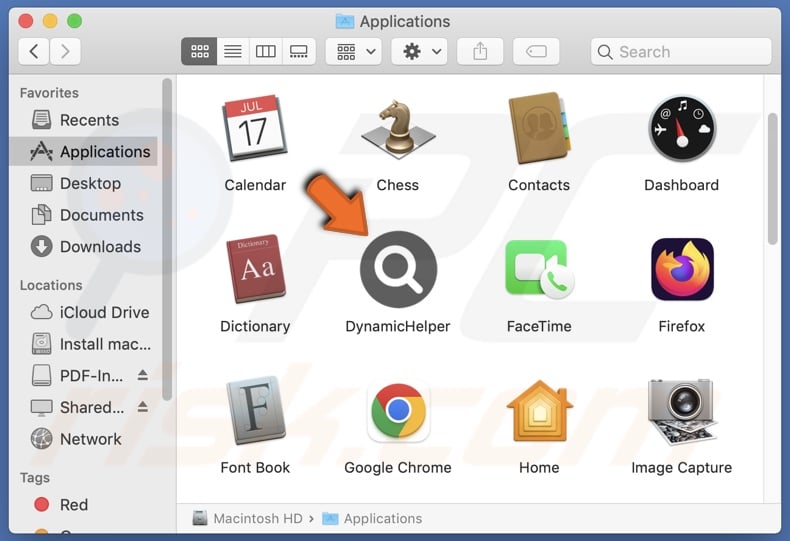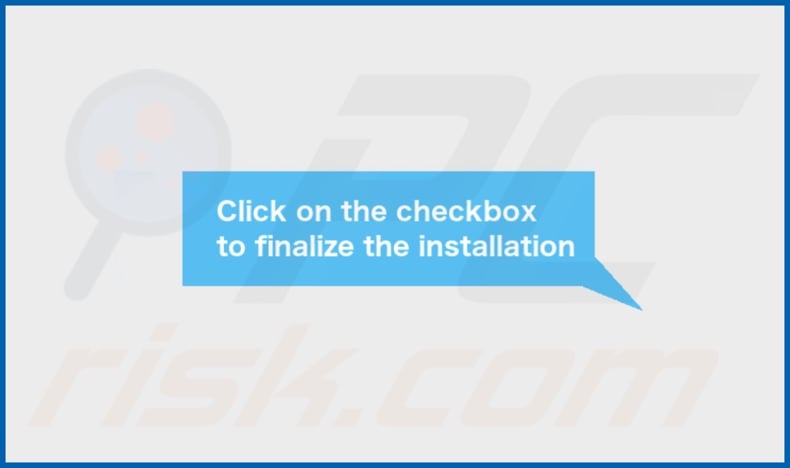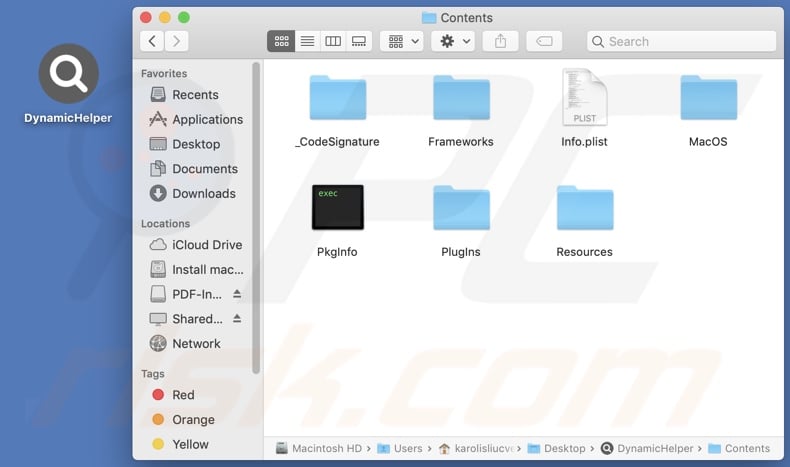Removal instructions for the DynamicHelper adware-type app
Mac VirusAlso Known As: Ads by DynamicHelper
Get free scan and check if your device is infected.
Remove it nowTo use full-featured product, you have to purchase a license for Combo Cleaner. Seven days free trial available. Combo Cleaner is owned and operated by RCS LT, the parent company of PCRisk.com.
What kind of application is DynamicHelper?
While inspecting new submissions to the VirusTotal platform, our research team discovered the DynamicHelper application. Upon examination, we determined that it is adware belonging to the AdLoad malware family. Advertising-supported software is designed to run intrusive advertisements, and it may have other harmful capabilities.

DynamicHelper adware overview
Adware is designed to generate revenue for its developers. This is typically achieved by placing third-party graphical content (e.g., banners, pop-ups, overlays, surveys, etc.) on visited websites, desktops, or other interfaces.
It must be mentioned that specific conditions may be required for adware to deliver intrusive advert campaigns (e.g., compatible browser/system or user geolocation, visits to particular sites, etc.). However, regardless of whether DynamicHelper displays advertisements – the presence of this app on a system threatens device/user safety.
Adware-delivered ads can promote online scams, untrustworthy/harmful software, and even malware. Some can be triggered (i.e., by being clicked) to execute scripts that perform stealthy downloads/installations.
Keep in mind that any genuine content encountered through these adverts is most likely endorsed by scammers abusing its affiliate programs in order to acquire illegitimate commissions.
AdLoad adware commonly has browser-hijacking functionalities – however, we did not observe these features while investigating the DynamicHelper application.
What is more, advertising-supported software usually has data-tracking abilities, and this might apply to DynamicHelper. Data of interest may include: visited URLs, viewed webpages, searched queries, Internet cookies, usernames/passwords, personally identifiable details, finance-related information, and so forth. The gathered data can be shared with and/or sold to third-parties.
In summary, software like DynamicHelper may cause system infections, severe privacy issues, financial losses, and even identity theft.
| Name | Ads by DynamicHelper |
| Threat Type | Adware, Mac malware, Mac virus |
| Detection Names | Avast (MacOS:Adload-AB [Trj]), Combo Cleaner (Gen:Variant.Adware.MAC.Adload.29), ESET-NOD32 (A Variant Of OSX/Adware.Synataeb.C), Kaspersky (Not-a-virus:HEUR:AdWare.OSX.Adload.g), Full List (VirusTotal) |
| Additional Information | This application belongs to Adload malware family. |
| Symptoms | Your Mac becomes slower than normal, you see unwanted pop-up ads, you are redirected to dubious websites. |
| Distribution methods | Deceptive pop-up ads, free software installers (bundling), torrent file downloads. |
| Damage | Internet browser tracking (potential privacy issues), display of unwanted ads, redirects to dubious websites, loss of private information. |
| Malware Removal (Windows) |
To eliminate possible malware infections, scan your computer with legitimate antivirus software. Our security researchers recommend using Combo Cleaner. Download Combo CleanerTo use full-featured product, you have to purchase a license for Combo Cleaner. 7 days free trial available. Combo Cleaner is owned and operated by RCS LT, the parent company of PCRisk.com. |
Adware examples
We have examined numerous adware-type apps; AppWinner, ManageOptimizer, AgentLocator – are just a couple of examples. Software within this category usually appears legitimate and useful.
Users may be lured into downloading/installing adware by promises of various "handy" functions. These functionalities seldom work as promised, and in most cases – they do not work at all. It must be stressed that operational features alone do not prove a software's legitimacy or safety.
How did DynamicHelper install on my computer?
Adware is proliferated using the bundling marketing tactic, which involves parking ordinary program installers with unwanted/malicious supplements.
Downloading from freeware and free file-hosting websites, Peer-to-Peer sharing networks, and other suspicious sources – poses a threat of bundled content infiltrating the system. The risk is further compounded by rushing through installation processes (e.g., ignoring terms, skipping steps/sections, using "Quick/Easy" settings, etc.).
Advertising-supported software is also spread by intrusive advertisements. Once clicked on, some of the adverts can execute scripts to perform downloads/installations without user consent.
Additionally, this software is promoted on legitimate-looking download webpages and scam sites. They are mainly accessed via redirects generated by mistyped URLs, spam browser notifications, websites using rogue advertising networks, intrusive ads, and adware (with browser force-opening abilities).
How to avoid installation of adware?
We highly recommend researching software before downloading or purchasing. Furthermore, all downloads must be made from official and trustworthy channels. When installing, it is important to read terms, explore available options, use the " Custom" or "Advanced" settings, and opt out of all additional apps, extensions, features, etc.
We also advise vigilance while browsing since fraudulent and malicious online content usually appears legitimate and innocuous. For example, intrusive adverts may look harmless – yet redirect to unreliable and questionable sites (e.g., scam-promoting, pornography, gambling, adult dating, etc.).
If you keep encountering advertisements and/or redirects of this kind, inspect the system and immediately remove all dubious applications and browser extensions/plug-ins. If your computer is already infected with DynamicHelper, we recommend running a scan with Combo Cleaner Antivirus for Windows to automatically eliminate this adware.
Pop-up window displayed once DynamicHelper adware's installation is over:

DynamicHelper adware's installation folder:

Instant automatic malware removal:
Manual threat removal might be a lengthy and complicated process that requires advanced IT skills. Combo Cleaner is a professional automatic malware removal tool that is recommended to get rid of malware. Download it by clicking the button below:
DOWNLOAD Combo CleanerBy downloading any software listed on this website you agree to our Privacy Policy and Terms of Use. To use full-featured product, you have to purchase a license for Combo Cleaner. 7 days free trial available. Combo Cleaner is owned and operated by RCS LT, the parent company of PCRisk.com.
Quick menu:
- What is DynamicHelper?
- STEP 1. Remove DynamicHelper related files and folders from OSX.
- STEP 2. Remove DynamicHelper ads from Safari.
- STEP 3. Remove DynamicHelper adware from Google Chrome.
- STEP 4. Remove DynamicHelper ads from Mozilla Firefox.
Video showing how to remove DynamicHelper adware using Combo Cleaner:
DynamicHelper adware removal:
Remove DynamicHelper-related potentially unwanted applications from your "Applications" folder:

Click the Finder icon. In the Finder window, select "Applications". In the applications folder, look for "MPlayerX","NicePlayer", or other suspicious applications and drag them to the Trash.
After removing the potentially unwanted application(s) that cause online ads, scan your Mac for any remaining unwanted components.
DOWNLOAD remover for malware infections
Combo Cleaner checks if your computer is infected with malware. To use full-featured product, you have to purchase a license for Combo Cleaner. 7 days free trial available. Combo Cleaner is owned and operated by RCS LT, the parent company of PCRisk.com.
Remove adware-related files and folders

Click the Finder icon, from the menu bar. Choose Go, and click Go to Folder...
 Check for adware generated files in the /Library/LaunchAgents/ folder:
Check for adware generated files in the /Library/LaunchAgents/ folder:

In the Go to Folder... bar, type: /Library/LaunchAgents/

In the "LaunchAgents" folder, look for any recently-added suspicious files and move them to the Trash. Examples of files generated by adware - "installmac.AppRemoval.plist", "myppes.download.plist", "mykotlerino.ltvbit.plist", "kuklorest.update.plist", etc. Adware commonly installs several files with the exact same string.
 Check for adware generated files in the ~/Library/Application Support/ folder:
Check for adware generated files in the ~/Library/Application Support/ folder:

In the Go to Folder... bar, type: ~/Library/Application Support/

In the "Application Support" folder, look for any recently-added suspicious folders. For example, "MplayerX" or "NicePlayer", and move these folders to the Trash.
 Check for adware generated files in the ~/Library/LaunchAgents/ folder:
Check for adware generated files in the ~/Library/LaunchAgents/ folder:

In the Go to Folder... bar, type: ~/Library/LaunchAgents/

In the "LaunchAgents" folder, look for any recently-added suspicious files and move them to the Trash. Examples of files generated by adware - "installmac.AppRemoval.plist", "myppes.download.plist", "mykotlerino.ltvbit.plist", "kuklorest.update.plist", etc. Adware commonly installs several files with the exact same string.
 Check for adware generated files in the /Library/LaunchDaemons/ folder:
Check for adware generated files in the /Library/LaunchDaemons/ folder:

In the "Go to Folder..." bar, type: /Library/LaunchDaemons/

In the "LaunchDaemons" folder, look for recently-added suspicious files. For example "com.aoudad.net-preferences.plist", "com.myppes.net-preferences.plist", "com.kuklorest.net-preferences.plist", "com.avickUpd.plist", etc., and move them to the Trash.
 Scan your Mac with Combo Cleaner:
Scan your Mac with Combo Cleaner:
If you have followed all the steps correctly, your Mac should be clean of infections. To ensure your system is not infected, run a scan with Combo Cleaner Antivirus. Download it HERE. After downloading the file, double click combocleaner.dmg installer. In the opened window, drag and drop the Combo Cleaner icon on top of the Applications icon. Now open your launchpad and click on the Combo Cleaner icon. Wait until Combo Cleaner updates its virus definition database and click the "Start Combo Scan" button.

Combo Cleaner will scan your Mac for malware infections. If the antivirus scan displays "no threats found" - this means that you can continue with the removal guide; otherwise, it's recommended to remove any found infections before continuing.

After removing files and folders generated by the adware, continue to remove rogue extensions from your Internet browsers.
Remove malicious extensions from Internet browsers
 Remove malicious Safari extensions:
Remove malicious Safari extensions:

Open the Safari browser, from the menu bar, select "Safari" and click "Preferences...".

In the preferences window, select "Extensions" and look for any recently-installed suspicious extensions. When located, click the "Uninstall" button next to it/them. Note that you can safely uninstall all extensions from your Safari browser - none are crucial for regular browser operation.
- If you continue to have problems with browser redirects and unwanted advertisements - Reset Safari.
 Remove malicious extensions from Google Chrome:
Remove malicious extensions from Google Chrome:

Click the Chrome menu icon ![]() (at the top right corner of Google Chrome), select "More Tools" and click "Extensions". Locate all recently-installed suspicious extensions, select these entries and click "Remove".
(at the top right corner of Google Chrome), select "More Tools" and click "Extensions". Locate all recently-installed suspicious extensions, select these entries and click "Remove".

- If you continue to have problems with browser redirects and unwanted advertisements - Reset Google Chrome.
 Remove malicious extensions from Mozilla Firefox:
Remove malicious extensions from Mozilla Firefox:

Click the Firefox menu ![]() (at the top right corner of the main window) and select "Add-ons and themes". Click "Extensions", in the opened window locate all recently-installed suspicious extensions, click on the three dots and then click "Remove".
(at the top right corner of the main window) and select "Add-ons and themes". Click "Extensions", in the opened window locate all recently-installed suspicious extensions, click on the three dots and then click "Remove".

- If you continue to have problems with browser redirects and unwanted advertisements - Reset Mozilla Firefox.
Frequently Asked Questions (FAQ)
What harm can adware cause?
Adware may diminish the browsing experience and system performance. The advertisements delivered by this software can promote content capable of causing severe issues (e.g., system infections, financial losses, etc.). Additionally, adware usually has data-tracking functionalities – hence, it is considered a threat to user privacy.
What does adware do?
Adware stands for advertising-supported software. It displays third-party graphical content (ads) on various interfaces. Furthermore, some adware types can force-open sites and gather private data.
How do adware developers generate revenue?
Adware generates revenue through content promotion. Its developers may earn commissions from ad clicks, website visits, file downloads, product purchases, service subscriptions, or similar. Most of the profit comes from affiliate programs.
Will Combo Cleaner remove DynamicHelper adware?
Yes, Combo Cleaner can scan systems and eliminate installed adware-type applications. It is noteworthy that manual removal (performed without the aid of security programs) might be ineffective. In some instances, various file remnants stay hidden within the system after the software has been manually removed. The remaining components may continue to run and cause issues. Therefore, it is essential to eliminate advertising-supported software thoroughly.
Share:

Tomas Meskauskas
Expert security researcher, professional malware analyst
I am passionate about computer security and technology. I have an experience of over 10 years working in various companies related to computer technical issue solving and Internet security. I have been working as an author and editor for pcrisk.com since 2010. Follow me on Twitter and LinkedIn to stay informed about the latest online security threats.
PCrisk security portal is brought by a company RCS LT.
Joined forces of security researchers help educate computer users about the latest online security threats. More information about the company RCS LT.
Our malware removal guides are free. However, if you want to support us you can send us a donation.
DonatePCrisk security portal is brought by a company RCS LT.
Joined forces of security researchers help educate computer users about the latest online security threats. More information about the company RCS LT.
Our malware removal guides are free. However, if you want to support us you can send us a donation.
Donate
▼ Show Discussion